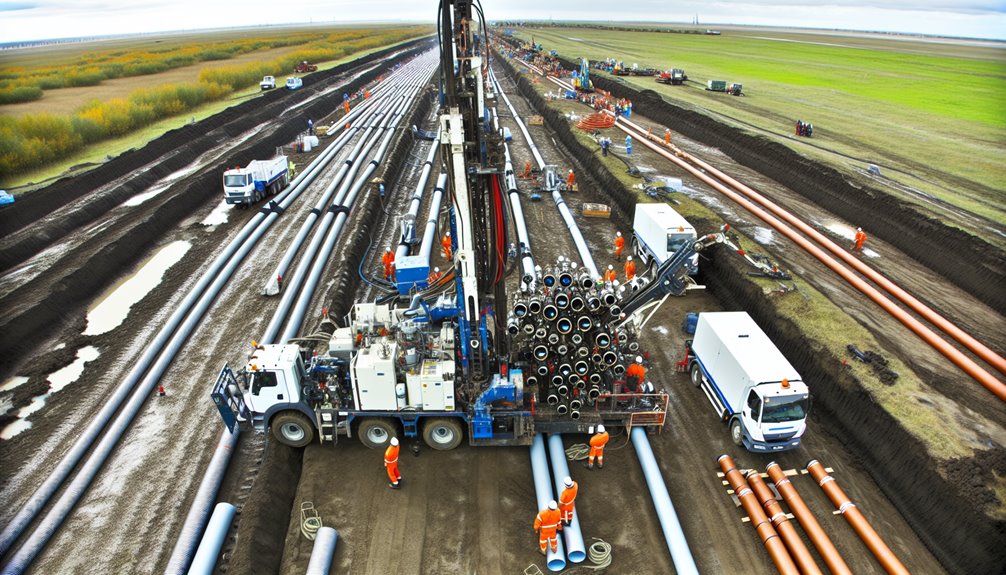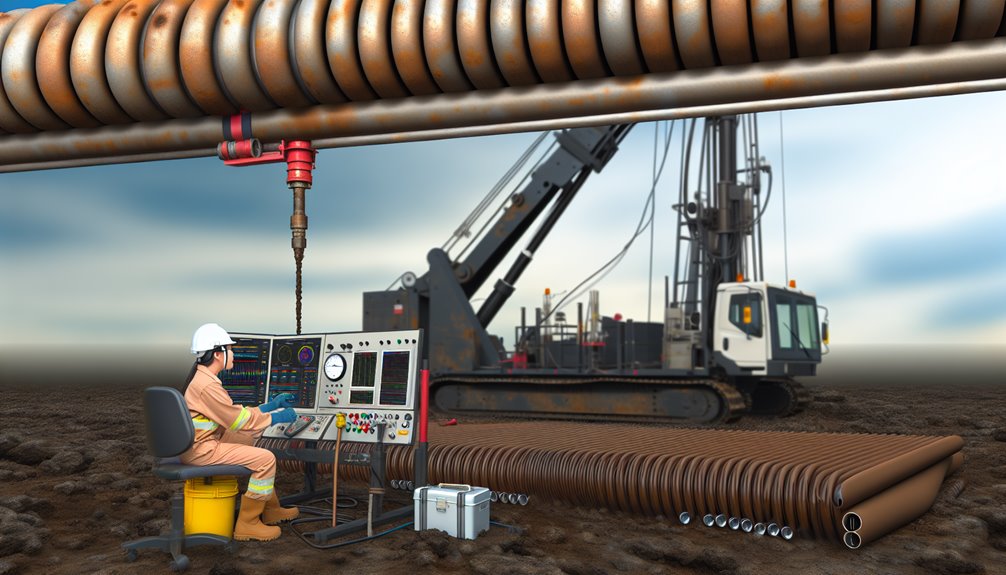When you're venturing into the world of Horizontal Directional Drilling (HDD), understanding its core principles and applications is essential. This technique, distinguished by its minimal disruption to the surrounding environment, involves precise directional control. You'll start by steering a pilot bore under obstacles like rivers or buildings, followed by enlarging the bore to accommodate various utilities. Grasping the subtleties of equipment and procedural steps can greatly influence project outcomes. Let's explore how mastering HDD can be a game-changer in infrastructure development.
Understanding Horizontal Directional Drilling

Horizontal Directional Drilling (HDD) is a sophisticated trenchless construction method used primarily for installing underground pipelines, conduits, and cables with minimal surface disruption. You'll find that precise drilling techniques and thorough soil analysis are essential to its success. Initially, a pilot hole is drilled, guided meticulously using advanced tracking systems to guarantee alignment with the preplanned route. Soil conditions are continuously analyzed, impacting the adjustments in drilling operations to avoid path deviations. During the process, real-time data from soil analysis informs decisions about the composition and flow of drilling fluids, critical for maintaining hole stability and preventing blockages. This method not only optimizes the drilling process but also enhances the safety and efficiency of installations across varied geological landscapes. To ensure the alignment and depth remain accurate throughout the process, a transmitter near the drill head continuously sends critical data to the location engineer.
Key Equipment Used in HDD
In the domain of Horizontal Directional Drilling (HDD), the selection and deployment of specialized equipment are vital for successful operations.
Here's a concise overview of the key tools:
- Directional Drilling Rigs: Choose from models like Vermeer's D80 X 100 or Ditch Witch's JT series based on your project's scale and complexity. These rigs are equipped with advanced features for handling diverse drilling conditions and are customizable.
- Locating Systems: Utilize systems such as the DigiTrak Eclipse® for precise tracking. These systems are essential for monitoring the bore path, providing real-time data on tool face, pitch, and depth through signal analysis.
- Drill Pipe and Tools: Select drill pipes with appropriate sizes and grades for the job's demands. High-quality drill bits designed for specific ground conditions enhance the drilling efficiency and lifespan of your equipment. Our range of equipment options cater to different drilling needs, ensuring we can adapt to the unique challenges of each project.
The Step-by-Step Process of Horizontal Directional Drilling

Understanding the step-by-step process of Horizontal Directional Drilling (HDD) is crucial for ensuring that your project meets both technical specifications and efficiency targets.
Initially, you'll tackle pilot hole drilling. This involves steering a drill along a pre-designed path using an electronic transmitter, which guides operations with real-time feedback. The drilling fluid plays a critical role here, cooling the drill bit and removing soil and rock fragments.
Next, you'll undertake reaming operations. Reamers progressively enlarge the pilot hole to accommodate the pipeline. Each pass uses larger reamers, continuously circulating drilling fluid to stabilize the borehole and extract debris.
This meticulous enlargement is essential to prepare the borehole for the subsequent pullback of the pipeline, aligning innovation with precision.
Common Challenges and Solutions in HDD
After exploring the meticulous steps involved in horizontal directional drilling, let's now examine the common challenges you may face and the effective solutions available.
Challenges and Solutions:
1. Variable Soil and Rock Conditions: You'll need to analyze the geological conditions meticulously to select the right drilling tools and mud systems.
For hard rock scenarios, opt for robust drill bits and advanced technologies to minimize equipment stress.
2. Existing Utilities and Obstacles: Implement precise utility mapping using technologies like GPR and electromagnetic tools to prevent damage and guarantee drilling safety.
Detailed planning is critical to navigate around these obstacles without causing service interruptions.
3. Restricted Workspaces: In urban settings, utilize compact drilling rigs and collaborate closely with local stakeholders to manage space constraints effectively while minimizing disruption.
Benefits of Using HDD Over Traditional Methods

While traditional drilling methods have their merits, horizontal directional drilling (HDD) offers substantial benefits that address modern construction and environmental challenges effectively.
You'll find that HDD isn't only more cost-effective due to its speed and reduced need for large machinery, but it also minimizes landscape disruption and labor costs. This technique preserves vital habitats and reduces soil displacement, essential in protecting sensitive ecosystems and maintaining natural landscapes.
Moreover, HDD guarantees significant cost savings by limiting the extent of post-job cleanups and avoiding extensive restoration work.
Importantly, this method dramatically lessens environmental impact, offering a 65% reduction compared to traditional methods, making it a superior choice for projects requiring stringent environmental protection measures.
Future Trends in Horizontal Directional Drilling Technology
As the construction and environmental landscapes continue to evolve, so too does the technology in horizontal directional drilling (HDD).
You'll find that future trends greatly emphasize automation advancements and drilling innovations.
Here's what you should watch for:
- Increased Automation: The integration of automated steering systems and real-time monitoring minimizes manual intervention, enhancing both accuracy and efficiency.
- Enhanced Drilling Fluids: New formulations are designed to reduce environmental impact while maintaining the effectiveness required for cooling, lubrication, and borehole stability.
- Advanced Drilling Rig Technology: Expect lighter, more compact rigs equipped with advanced telemetry for better access and control, greatly cutting down on energy costs and improving operational efficiency.
These developments promise to redefine your approach to HDD projects, making them faster, safer, and more cost-effective.
Conclusion
As you commence your next project, consider the strategic advantages of Horizontal Directional Drilling (HDD). By utilizing HDD, you'll minimize environmental impact and disruption to the surrounding area. Always guarantee you're equipped with the right tools and have a clear understanding of the process to tackle common challenges effectively. Stay abreast of technological advancements to enhance efficiency and cost-effectiveness. Adopting HDD not only aligns with modern engineering practices but also secures a sustainable future in infrastructure development.
If you're curious to learn more about Horizontal Directional Drilling and how it can benefit your projects, I invite you to visit Boring Bros at boringbro.com. They have a wealth of resources that can help you dive deeper into this innovative technique. Or feel free to give them a call at (954) 639-6167. I'm sure they'll be happy to assist you with any questions you may have!

